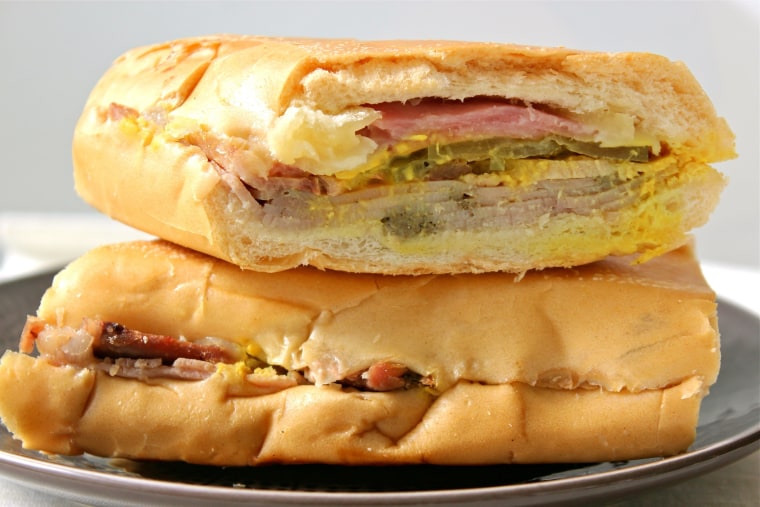The problem started with the salami. And the debate over this fatty little cold cut is about as fierce as the debate over what will happen in Cuba after Fidel Castro, dictator for more than 50 years, dies. At issue is cultural pride, culinary authorship and, above all, whether a classic sanwich cubano includes, among other ingredients, one that's...Italian? While definitive answers are hard to come by, where you stand in the Great Cuban Sandwich Debate likely depends on where you're from.
First, what everyone does agree on: a Cuban sandwich is made with slices of mojo-flavored roasted pork butt, mild, smoked ham (none of the wet, boiled, processed stuff), Gouda or Swiss cheese, pickles and mustard. Everyone also agrees Cuban bread is paramount and can never be replaced with, for instance, crusty French bread. (Ask anyone who's tried that and you may not hear an opinion since the roof of their mouth is probably still bleeding.) Lastly, it's universally understood the sandwich is better when slathered in butter and pressed to melty perfection.
That's where agreement ends and disputes begin.
If you're from Tampa, Florida, home to the US's first Cuban community (dating back to the 1880s when Spanish and Cuban immigrants fled poverty and war for an opportunity to work in the budding cigar industry in Tampa's historic Ybor City neighborhood) you likely believe your Tampa ancestors are responsible for inventing the cubano and that salami is part of the original and authentic list of ingredients. Why? Because as Andy Huse, a University of South Florida librarian who works in the school's Florida Studies Center, extensively researching the sandwich's origins, argues "the original Tampa cubano included a sliced salchichón, which was a Spanish cured, dried sausage. That became hard to find here in America, and it was replaced with the much more accessible salami, which was similar." Tampa natives also believe their Cuban bread, which they say is notably more crusty and flaky than the kind made in Miami, is also more authentic. Huse points to the fact that Tampa's bread is made with the same recipe and technique used more than 100 years ago, proof of pedigree and heritage.
While all of this seems logical enough, suggest it to a Cuban from Miami and you're in for a bona fide smack-down, not to mention an earful about how South Florida — not West Coast Florida — is the U.S. Cuban capital. Indeed, Miami Cubans take a puritan stand. As Mayor Tomas Regalado recently told NPR, "If my abuela would have seen salami in a Cuban sandwich she would do the sign of the cross and say that's a sacrilege." In Miami, only the most authentic ingredients (ham, pork, cheese, pickle and mustard) are allowed into a cubano. Salami, they say, belongs on a pizza. Or someone else's sandwich. And the bread? "Um, our bread is Cuban. It's made in the same way the 800 different Cuban bakeries in Miami make Cuban bread," says Felipe Valls Jr., whose family has owned Little Havana's iconic Versailles restaurant for more than four decades. "Every human I know knows the Cuban sandwich without salami, as we know it in Miami. Tampa may have a Cuban sandwich that goes back a long time, but Miami made this sandwich famous."
Not surprisingly, Tampa isn't standing down. Not only did the city last month decide to claim the "historic Tampa cubano" as its signature sandwich, a move that inflamed the South Florida purists, but this weekend Ybor City will be home to the first official Cuban Sandwich Festival.
As the debate rages on, perhaps the best thing to do is savor in the discord. Or ponder the one other fact people seem to agree on: that in Cuba itself the sandwich was never called a sanwich cubano. It was called un sanwich (as in, a sandwich) or un mixto (as in a mix of meats, which suggests the islanders may not have been nearly as concerned with the salami issue.)
Below is the official Cuban sandwich recipe from Versailles, where about 500,000 cubanos are sold every year. (For those on Tampa's side of the argument: add a slice or two of salami to make this yours, or check out this recipe from Ybor City's Columbia Restaurant.)
Versailles Cuban Sandwich
6 oz sugar baked sweet bolo ham, sliced
4 oz roasted fresh leg of pork seasoned Cuban style, sliced
4 oz imported Swiss cheese, sliced
3 pickle slices
Mustard
Cuban bread
1. Cut a loaf of Cuban bread in 3 pieces. Slice one of those pieces length wise.
2. On bottom slice add ham, pork, cheese and mustard.
3. On top slice squeeze a thin line of mustard and spread it.
4. Join both halves and lightly butter the outsides.
5. Place sandwich on a double sided flat panini grill. Leave until cheese is melted and outside is toasty.
6. Slice sandwich in half diagonally and serve immediately.
Betty Cortina, senior consulting web producer for NBCLatino.com, believes salsa (the condiment as well as the music) makes the world a more delicious place.
More Cuban food recipes from NBC Latino:
